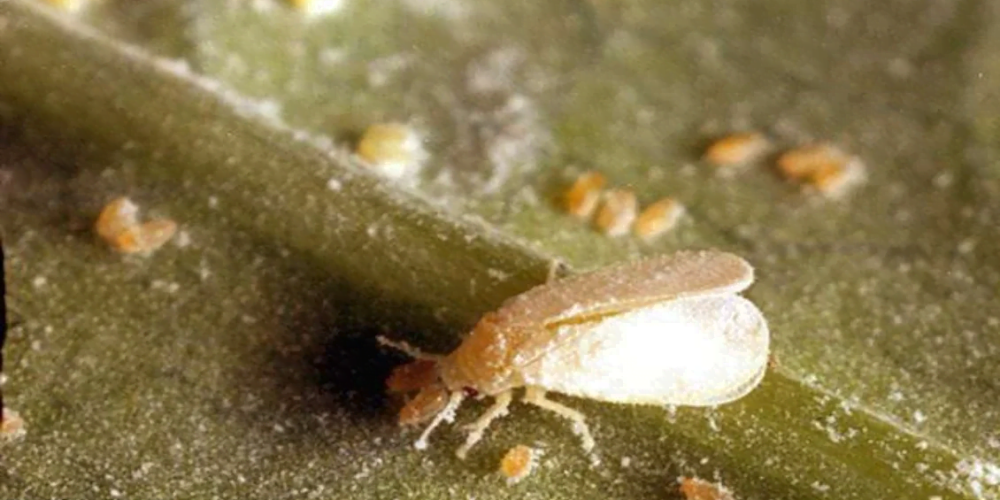Whitefly: The whitefly Bemisia tabaci
The whitefly infestation appears from April to early clusters and from June and October to late clusters, and it is one of the most common clusters of the insect.
Symptoms of infestation: Whiteflies feed on leaves by sucking plant sap, which leads to yellowing and wrinkling of leaves, small leaf size, and plant weakness. * Insects secrete honeydew, where black mold fungi grow on it. * One of the most dangerous effects of whiteflies on plants is that they transmit viral diseases to eggplant plants.
considered as Eggplant white fly) is one of the most important economic insects that infect eggplant crops and plants. This dangerous pest also leads to great weakness of the infected plant and a decline in agricultural and economic production for the farmer. What are the signs and manifestations of infection with the eggplant white fly, and how can the farmer combat the eggplant white fly?
The most important information about the insect
The eggplant white fly is one of the dangerous agricultural pests recorded as an insect that harms the economic output of eggplant, whether in field agriculture or greenhouses (plastic and glass). This insect is widespread in all eggplant growing areas around the world, but it is abundant in the Mediterranean basin, such as Syria. Iraq, Jordan, Cyprus, Palestine, and coastal areas characterized by a moderate climate.
The economic threshold of damage is estimated at more than 70% and may reach 80% if the infestation of this fly worsens in greenhouses or in vegetable fields planted with this plant.
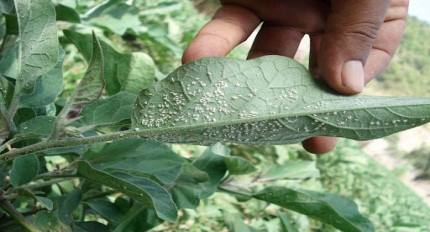
Description of the appearance of the eggplant white fly
The appearance of the eggplant white fly is similar to other types of white flies, especially the lemon white fly, Dialourodes citri. For this reason, it is difficult for the average farmer and peasant to distinguish it from others. Below is the precise description of the fly:
The full instar of the eggplant whitefly
The adult insect is a small fly with a size ranging between 1.5-2.5 mm. The fly is a creamy white color due to the presence of a white waxy substance covering the body and wings together. The color ranges between creamy white and waxy yellow.
It is noted that the wings are longer than the body and are usually opaque, but when the yellow wax layer is removed from them, they then become transparent.
Young, incomplete ages of the fly
While the nymphs or incomplete young instars are yellow-white in colour, as the nymphs are mobile in the first instar, but in the following instar they are stationary in their feeding places in the leaves and are active in sucking the sap. In addition, the nymphs are protected by a transparent covering, which gives them the appearance of a full fly or a full stage, even though they are not.
Eggplant whitefly egg shape
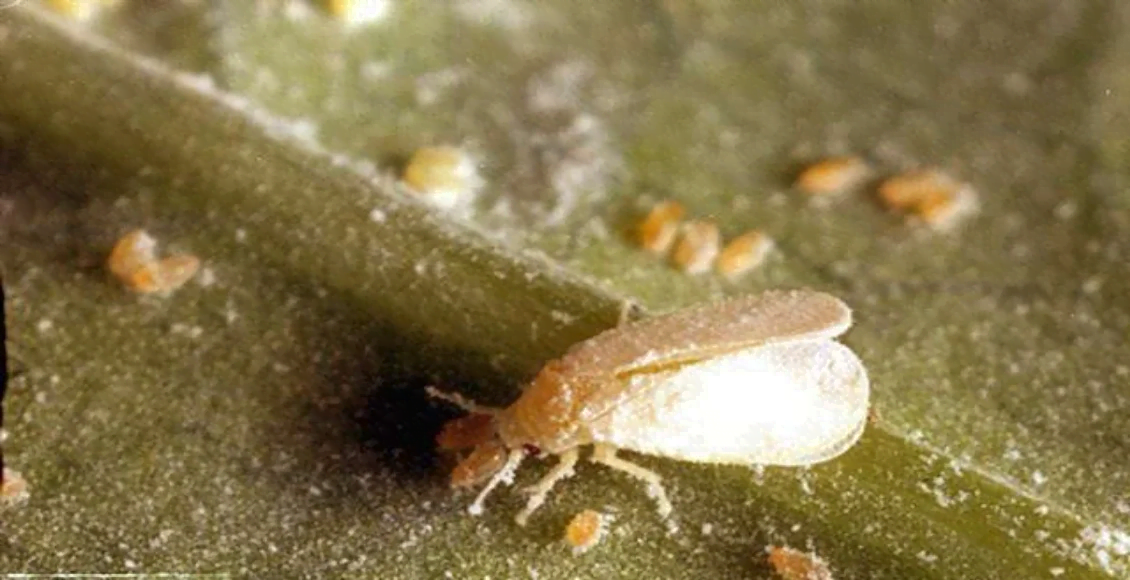 After the eggs hatch, the egg is lemon-shaped, oval to round, firmly attached to a small carrier. The color of the egg is either creamy white or lemony yellowish white, and is not dark at first. The egg quickly turns dark greenish-yellow upon hatching, that is, after about twenty to forty days, depending on humidity, weather, and conditions.
After the eggs hatch, the egg is lemon-shaped, oval to round, firmly attached to a small carrier. The color of the egg is either creamy white or lemony yellowish white, and is not dark at first. The egg quickly turns dark greenish-yellow upon hatching, that is, after about twenty to forty days, depending on humidity, weather, and conditions.
Eggplant white fly infestation results from both the complete and incomplete stages of the fly, and the symptoms are characterized as follows:
- Adult flies and young nymphs feed on the sap of eggplant leaves from the lower surface, causing their color to turn pale.
- After this, the leaves wilt and dry and fall dramatically, or they may wilt stuck on the eggplant plant infected with the fly and appear unnatural to the farmer’s eye.
- The flies also secrete a dense honeydew on which the black mold fungus grows in a white layer on the eggplant leaf.
- Contaminated dust also sticks to the aforementioned layer, and the appearance of the paper appears dull and not good
- Then, with gradual development and when the infection is severe, the eggplant plants appear to the eyes of the farmer and the observer to be completely blackened, even from a distance.
- In most cases, this causes a significant weakness in the eggplant crop and a decrease in the level of eggplant production by a rate ranging between 40-80% when severe.
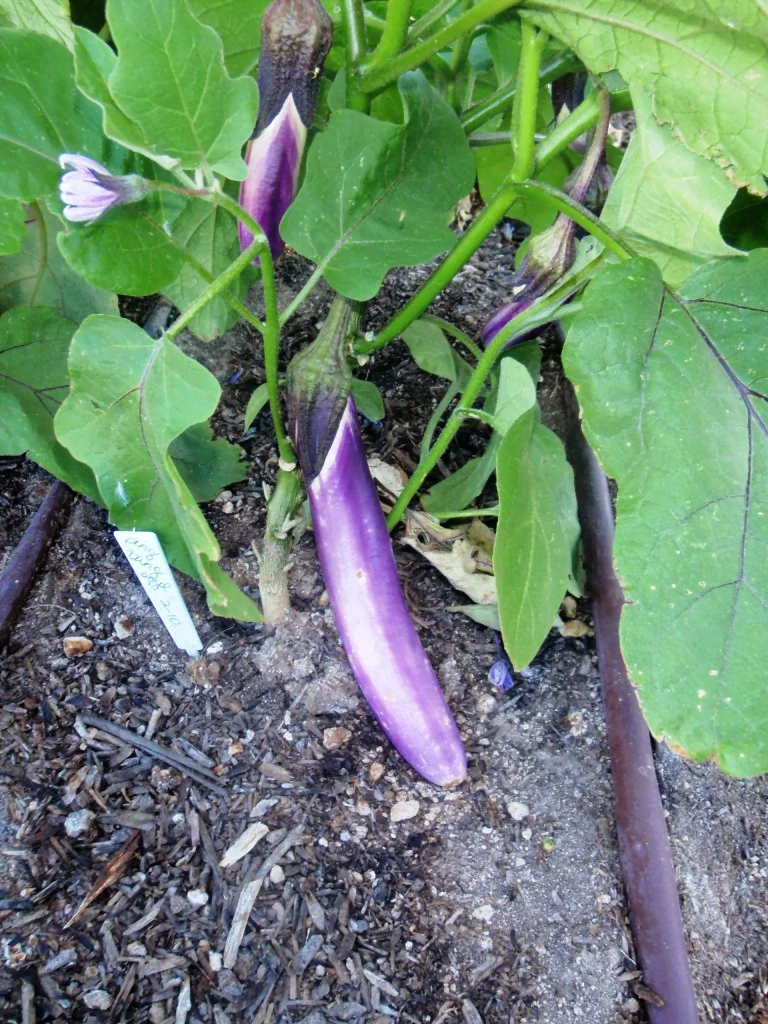
Factors that increase the chances of infection with the pest
The most important and prominent factors and reasons that increase the chances of infection with the eggplant white fly:
- Not planting eggplant at appropriate distances, whether in vegetable fields or in plastic and glass greenhouses, as this leads to an increase in plant density/unit area and encourages flies due to lack of ventilation and high humidity.
- Eggplant plants are also suffocated by weak, unbalanced, and ill-considered ventilation in the plastic and glass house, especially because it is closed and needs air from time to time.
- The farmer does not pay attention to service operations and does not give importance to pruning, fertilizing, and regular irrigation of eggplant plants, whether in the greenhouse or in the field.
- Neglecting balanced fertilization with NPK elements for eggplant plants will cause it to lack nutrients and weaken its immunity to flies.
Degree of damage to the eggplant white fly
The harm of the eggplant white fly is very high, as it is considered one of the most dangerous types of white flies. The danger stems from many factors, the most important of which are:
- The most important thing is that this fly is considered one of the suckers of plant juices, thus impairing the respiration and growth of eggplant plants.
- The fly also attracts many pests to infected plants, including other whiteflies (greenhouse flies), viruses, and black mold fungi.
- Among the most important pests that are attracted are many types of scale insects, such as the black, cup, and brown eggplant scale insect, mites, mites, and spiders (European, red...).
- Also, the weakness of the affected plant attracts other non-insect pests, the most important of which are harmful bacteria such as late and early blight (especially when growing tomatoes with eggplant), and fungi such as wilt disease.
- In addition to all of the above, the number of pesticides registered that are effective against this fly is small, and it is always preferable to use Acetamiprid because its strong and wonderful effectiveness has been proven compared to other pesticides such as DDT or even parathion methyl.
Life cycle of the eggplant white fly
The life cycle of the eggplant whitefly is as follows:
Warm up and disperse the fly
The fly spends its warm-up phase in the winter in the form of a fully mature nymph in its last life, that is, it is about to become a full-fledged fly. We can also call the previous stage (semi-pupal or full-like fly), because this stage resembles a pupa. During rest, the fly is present on the lower surface of the eggplant leaves, and it protects and prepares to enter the attack phase.
Attack and feeding stage of the pest
This stage comes when spring arrives, around April, and the flies emerge from their nests, active and energetic, having finished warming up. After that, the pest mates, and the female lays approximately 80-95 eggs, and it may reach approximately 100 eggs, which are suspended and attached to a small carrier on the lower surface of the young green leaves, in a way that can be said to be random.
Stage of fly development
The eggs hatch after about 14-40-45 days, and after that, the mobile nymphs emerge and continue their development, going through several ages, feeding on plant juices for a little, then fixing on the feeding sites on the eggplant leaves when they turn into the feeding phase. There is an increase in the number of the insect, especially when there is a lack of ventilation and high air humidity in eggplant fields, especially in closed plastic and glass houses. This encourages the fly because it suffocates the plant and reduces the benefit of water, air, and food.
Number of generations of eggplant whitefly
The number of generations of eggplant whitefly actually varies depending on temperature and humidity, especially in eggplant fields and closed greenhouses. In the cool, temperate coastal areas of the Mediterranean, this fly gives 3 generations, and in other areas 5-6 generations per year in eggplant growing places that follow the pattern of intensive agriculture per unit area.
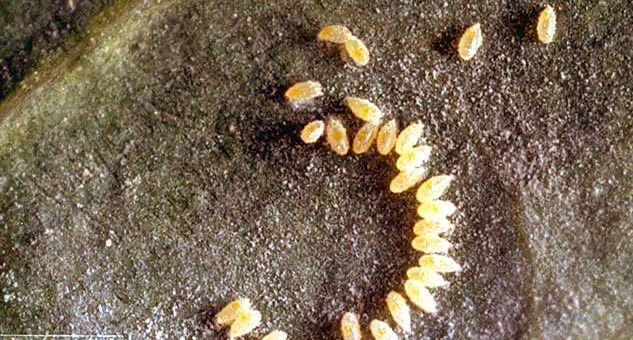
Preventive control of flies
Preventive control of the eggplant white fly is carried out through important things that the farmer must achieve:
- Eggplants are planted at appropriate distances in homes or fields, which are 40 cm between the lines and the same between the plants, or 45 cm between the lines and 35 cm between the plants on one line.
- It is strongly preferred for the farmer to reduce the air humidity in greenhouses and greenhouses for growing eggplant.
- The ventilation of plants and fields must also be balanced in the event of drought. Ventilation is done by pruning intertwined and crowded eggplant branches, especially those close to the soil surface.
- The farmer takes good care of the plants through regular and directed irrigation by regulating the number and timing of irrigation. This is sufficient for prevention, as prevention is better than cure.
- It is necessary to avoid growing eggplant at a high density, and to take into account ensuring the plant’s needs for food, water, air, and fertilizer. In this regard, it is preferable to use the technique of fertilizers soluble in irrigation water.
- In addition to what was mentioned, weeds that are considered an infested place for the fly pupae to rest, the pest to multiply, and the spread of the eggs to the eggplant fields and then into the greenhouses, must be eliminated, as well as the transmission of the infection to neighboring fields.
Therapeutic control of eggplant white fly
While therapeutic control is a control carried out in order to kill and eradicate the fly from its roots when the eggplant is infected and to avoid it in the subsequent season of planting. Control is carried out through the use of pesticides that have actually been proven to be beneficial for this fly, such as the wonderful and best pesticide Aseta Mebrid. AcetamipridAnd the pesticide Dimeton. The pesticide methidathion can also be used by spraying eggplant leaves infected with the fly. In addition to the above, the pesticide nicotine-sulphate gives good results. Also, one of the pesticides can be strengthened with low-quality summer oil. For this purpose, the pesticide Parathion methyl is used and sprayed on eggplant leaves infected with the fly.
Program for the use of pesticides against flies
In order for the farmer to avoid the fly developing resistant strains within the infected eggplant fields and places where he grows, he follows a special pesticide cycle and a balanced program, where he uses the pesticide Acetamiprid in the first season of infection by spraying it on the infected eggplant leaves. In the season following the infection of the eggplant, the pesticide Parathion is used by spraying it on the affected eggplant plants, targeting the leaves infected with the fly and the nymph. While in the third season, the pesticide Dimethoate or Dimeton s methyl is sprayed on the affected eggplant leaves in April, again in July, and a third time in October, with the condition that the ring itself be changed after 9 years and used. New pesticides, provided that they have the same properties and (the composition is different) and that they are phosphorus-organic and systemic.
Biological insect control
While biological control is control based only on natural enemies, such as predators and parasites of flies in eggplant fields, which are abundant in the fields. Biological control contributes to reducing the costs and expenses of pesticides for farmers and producers. It also helps provide protection and vital support for the environment and eggplant plants affected by flies and exposed to pests. The parasite Encarsia armata can be relied upon, and it is also beneficial to propagate the predator, Coccinella syptempunctata, known as the seven-spotted bird, and release it into eggplant fields infested with the fly.
